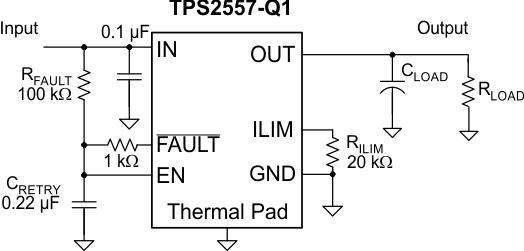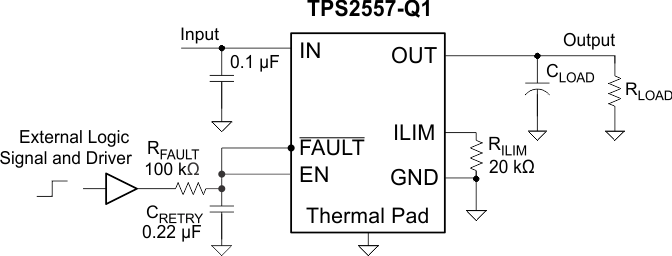SLVSC97B March 2014 – September 2020 TPS2556-Q1 , TPS2557-Q1
PRODUCTION DATA
- 1 Features
- 2 Application
- 3 Description
- 4 Revision History
- 5 Device Comparison Table
- 6 Terminal Configuration and Functions
- 7 Specifications
- 8 Detailed Description
- 9 Applications and Implementation
- 10Power Supply Recommendations
- 11Layout
- 12Device and Documentation Support
- 13Mechanical, Packaging, and Orderable Information
Package Options
Mechanical Data (Package|Pins)
- DRB|8
Thermal pad, mechanical data (Package|Pins)
- DRB|8
Orderable Information
8.4.3 Auto-Retry Functionality
Some applications require that an overcurrent condition disable the device momentarily during a fault condition and re-enables it after a preset time. This auto-retry functionality can be implemented with an external resistor and capacitor. During a fault condition, FAULT pulls EN low. Pulling EN below the turnoff threshold disables the part is disabled, and FAULT goes into the high-impedance state, allowing CRETRY to begin charging. The device re-enables when the voltage on EN reaches the turnon threshold. The resistor-capacitor time constant determines the auto-retry time. The device continues to cycle in this manner until removal of the fault condition.
 Figure 8-1 Auto-Retry Functionality
Figure 8-1 Auto-Retry FunctionalitySome applications require auto-retry functionality and the ability to enable and disable with an external logic signal. Figure 8-2 shows how an external logic signal can drive EN through RFAULT and maintain auto-retry functionality. The resistor-capacitor time constant determines the auto-retry time-out period.
 Figure 8-2 Auto-Retry Functionality With External EN Signal
Figure 8-2 Auto-Retry Functionality With External EN Signal